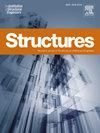Mechanical properties of grouted sleeve splice with horizontal grouting defect after exposure to high temperature
IF 4.3
2区 工程技术
Q1 ENGINEERING, CIVIL
引用次数: 0
Abstract
Grouted sleeve splice is an important part of prefabricated concrete components. The performance and reliability of structures are directly impacted by the grouted sleeve splice between the steel bar and grouted sleeves. After exposure to high temperatures, the horizontal grouting defects are of great significance in terms of the mechanical properties of grouted sleeve splices. The mechanical properties of grouted sleeve splices at five horizontal grouting defect rates (0, 10, 15, 20, 25 and 30 %) after being exposed to four kinds of temperatures (room temperature, 200, 400 and 600 °C) were analyzed. The defect rate refers to the mass of missing grout within the grouted sleeve as a percentage of the grout mass in a fully grouted sleeve. The findings demonstrated that rebar fracture and rebar pull-out were the main causes of the failure of the grouted sleeve splice. Only the grouted sleeve splice with defect rate of 30 % exhibited the rebar pull-out failure under room temperature. The compressive strength of the grout gradually decreased with increasing temperature. After exposure to 600 °C, the strength had declined by approximately 50 % compared to ambient conditions. After exposure to 600 °C, the mechanical properties of rebars began to degrade, and the yield strength and ultimate strength of rebars decreased by 6.1 % and 5.9 % respectively compared with normal temperature. Furthermore, for the specimens with a defect rate of 10 %, the failure mode shifted from rebar fracture to rebar pull-out as the temperature rose to 600 ℃. The drastic decline in ultimate load of the grouted sleeve splice led to a significant reduction in ultimate slippage.
水平注浆缺陷灌浆套筒接头高温暴露后力学性能研究
灌浆套筒接头是预制混凝土构件的重要组成部分。钢筋与灌浆套筒之间的灌浆套筒接头直接影响结构的性能和可靠性。高温作用后,水平注浆缺陷对灌浆套筒接头的力学性能有重要影响。分析了在4种温度(室温、200、400和600℃)下,水平注浆缺缺率(0、10、15、20、25和30 %)下,灌浆套筒接头的力学性能。缺陷率是指灌浆套筒内缺失的灌浆质量占完全灌浆套筒中灌浆质量的百分比。结果表明,钢筋断裂和钢筋拔出是导致注浆套筒接头失效的主要原因。在室温条件下,只有缺缺率为30% %的灌浆套筒接头出现了拉拔破坏。随着温度的升高,浆液的抗压强度逐渐降低。暴露于600°C后,强度与环境条件相比下降了约50% %。暴露于600℃后,钢筋的力学性能开始退化,钢筋的屈服强度和极限强度分别比常温降低了6.1 %和5.9 %。对于缺陷率为10 %的试件,随着温度升高至600℃,破坏模式由钢筋断裂转变为钢筋拔出。注浆套筒接头极限载荷的急剧下降导致了极限滑移的显著降低。
本文章由计算机程序翻译,如有差异,请以英文原文为准。
求助全文
约1分钟内获得全文
求助全文
来源期刊

Structures
Engineering-Architecture
CiteScore
5.70
自引率
17.10%
发文量
1187
期刊介绍:
Structures aims to publish internationally-leading research across the full breadth of structural engineering. Papers for Structures are particularly welcome in which high-quality research will benefit from wide readership of academics and practitioners such that not only high citation rates but also tangible industrial-related pathways to impact are achieved.
 求助内容:
求助内容: 应助结果提醒方式:
应助结果提醒方式:


